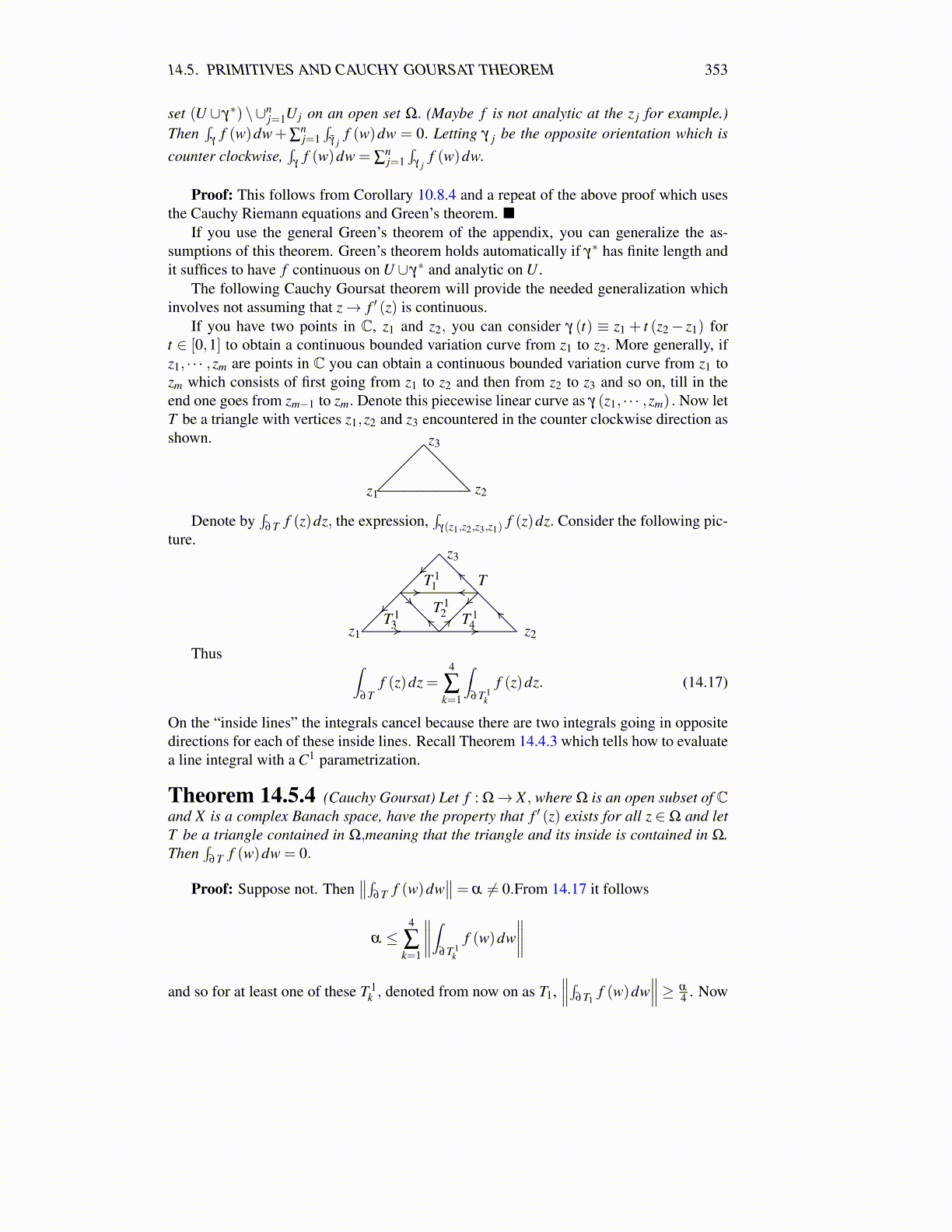
14.5. PRIMITIVES AND CAUCHY GOURSAT THEOREM 353
set (U ∪ γ∗) \∪nj=1U j on an open set Ω. (Maybe f is not analytic at the z j for example.)
Then∫
γf (w)dw+∑
nj=1∫
γ̄ jf (w)dw = 0. Letting γ j be the opposite orientation which is
counter clockwise,∫
γf (w)dw = ∑
nj=1∫
γ jf (w)dw.
Proof: This follows from Corollary 10.8.4 and a repeat of the above proof which usesthe Cauchy Riemann equations and Green’s theorem. ■
If you use the general Green’s theorem of the appendix, you can generalize the as-sumptions of this theorem. Green’s theorem holds automatically if γ∗ has finite length andit suffices to have f continuous on U ∪ γ∗ and analytic on U .
The following Cauchy Goursat theorem will provide the needed generalization whichinvolves not assuming that z→ f ′ (z) is continuous.
If you have two points in C, z1 and z2, you can consider γ (t) ≡ z1 + t (z2− z1) fort ∈ [0,1] to obtain a continuous bounded variation curve from z1 to z2. More generally, ifz1, · · · ,zm are points in C you can obtain a continuous bounded variation curve from z1 tozm which consists of first going from z1 to z2 and then from z2 to z3 and so on, till in theend one goes from zm−1 to zm. Denote this piecewise linear curve as γ (z1, · · · ,zm) . Now letT be a triangle with vertices z1,z2 and z3 encountered in the counter clockwise direction asshown.
z1 z2
z3
Denote by∫
∂T f (z)dz, the expression,∫
γ(z1,z2,z3,z1)f (z)dz. Consider the following pic-
ture.
TT 11
T 12T 1
3 T 14z1 z2
z3
Thus ∫∂T
f (z)dz =4
∑k=1
∫∂T 1
k
f (z)dz. (14.17)
On the “inside lines” the integrals cancel because there are two integrals going in oppositedirections for each of these inside lines. Recall Theorem 14.4.3 which tells how to evaluatea line integral with a C1 parametrization.
Theorem 14.5.4 (Cauchy Goursat) Let f : Ω→ X , where Ω is an open subset of Cand X is a complex Banach space, have the property that f ′ (z) exists for all z ∈Ω and letT be a triangle contained in Ω,meaning that the triangle and its inside is contained in Ω.Then
∫∂T f (w)dw = 0.
Proof: Suppose not. Then∥∥∫
∂T f (w)dw∥∥= α ̸= 0.From 14.17 it follows
α ≤4
∑k=1
∥∥∥∥∫∂T 1
k
f (w)dw∥∥∥∥
and so for at least one of these T 1k , denoted from now on as T1,
∥∥∥∫∂T1f (w)dw
∥∥∥≥ α
4 . Now